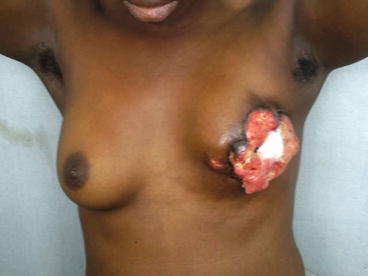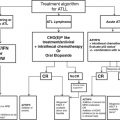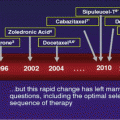Triple test: clinical, USS, Trucut/FNAC
One-day, one-stop triple diagnosis
Incision/excision biopsy as indicated
Mandatory pathology and IHC testing
Staging: CXR, abdominal USS, bone scintigraphy
4 Management of Breast Cancer in Africa
4.1 Locoregional Treatment
4.1.1 Surgery
Surgery is the mainstay for primary treatment of breast cancer in Africa. Because of stage at presentation, level of infrastructure, cost of more complex treatments and availability of adjuvant therapies, modified radical mastectomy remains the standard of care for patients with early and locally advanced breast cancer, as well as advanced breast cancer that has been sufficiently downstaged by neoadjuvant treatment. Post-mastectomy reconstruction is not widely practised and patients use external breast prosthesis. Breast conservation treatment may be suitable for a small proportion of women but needs to be used with care so that patients do not receive suboptimal management. Patients with advanced disease are treated symptomatically according to the affected systems of the body.
Fungating ulcerated malignant breast tumours with purulent, malodorous and sloughy floor are common and can be treated with honey dressing and topical application of metronidazole solution (Fig. 1). If they bleed, this can be controlled by radiotherapy or topical application of formalin solution [23].


Fig. 1
A young lady with ulcerated fungating malignant ulcer of the left breast
4.1.2 Radiotherapy
There is paucity of radiotherapy services in Africa. A preponderance of locally advanced cancer and the lack of modern radiotherapy technology limit available services to mainly palliative radiotherapy [24]. Where available, its uses include adjuvant treatment of early and locally advanced tumours, neoadjuvant treatment of advanced cases and treatment of bone and brain metastases. Urgent irradiation of localised metastases in the spine or long bones that are threatening to collapse or fracture may predate systemic chemotherapy in stage IV disease. Radiation therapy is also indicated in selected cases for pain control and for securing haemostasis for intractable bleeding from malignant ulcers.
4.2 Systemic Treatment
4.2.1 Chemotherapy
Anthracycline-containing combination regimens are recommended as the first-line adjuvant or neoadjuvant treatment of breast cancer. Taxane-containing combinations, e.g. capecitabine and docetaxel or gemcitabine and paclitaxel, are effective second-line options. They are also recommended for use in patients with extensive or progressing visceral metastases and who have good performance status. Capecitabine monotherapy may be advisable in some elderly patients and in patients who may not require more intensive chemotherapy [25]. In advanced diseases, objective tumour response should be assessed every two or three cycles and treatment changed or discontinued as required. Supportive treatment for complications of chemotherapy, including anti-emetics, should be available.
4.2.2 Endocrine Therapy
Controversy about prevalence of hormone receptor-poor tumours in African breast cancer patients are now largely resolved with carefully controlled studies showing that there is no substantial difference with other populations and majority of patients have receptor-positive tumours. This should increase use of hormone treatments including in cases where tumour receptor status is unknown [26, 27].
For premenopausal women, tamoxifen tablets for a minimum of 5 years are treatment of choice. Ovarian ablation with tamoxifen can be used in those who experience disease progression following previous tamoxifen treatment. Tamoxifen for 5 years or for 2–3 years, followed by aromatase inhibitors, is recommended in hormone receptor-positive postmenopausal women. Continuous aromatase inhibitors for 5 years are advised for postmenopausal women with no prior history of endocrine therapy [28, 29]. Chemotherapy and endocrine therapy should be administered sequentially and not concurrently. As neoadjuvant treatment, endocrine therapy should be the choice in elderly patients with locally advanced or widely metastatic hormone receptor-positive breast cancer.
4.3 Other Adjunct Therapies
Biological therapy with trastuzumab and lapatinib targeted at HER-2 receptors, which are over-expressed in about 20 % of breast tumours where it causes tumour cell proliferation and metastasis, is recommended in HER-2-positive breast cancer. Trastuzumab is indicated in both adjuvant and metastatic settings and is readily available in Africa. However, costs and logistics limit its use in many patients with HER-2-positive breast cancer. Tumour responses in clinical trials of many anti-angiogenic drugs have been highly variable and these drugs are not currently standard of care [30].
4.4 Management of Complications of Breast Cancer
Most African women with breast cancer present in the hospital with either locally advanced or metastatic disease. In many instances, patients present in the hospital for the first time with complications arising from distant metastasis, and these sometimes require emergency surgical intervention. In Table 2 is an annotation of common complications and their management which should be pursued together with the appropriate systemic anti-neoplastic treatment.





Table 2
Common complications of metastatic breast cancer and their management
Drainage of effusion by thoracocentesis under aseptic conditions |
Closed thoracostomy tube drainage (CTTD) followed with tetracycline-induced pleurodesis |
Respiratory support with bronchodilators, antibiotics, steroids, supplemental oxygen and opioid analgesics |
Fungating malignant ulcers |
Topical metronidazole and honey dressing |
Topical dressing with formalin-soaked gauze for multiple-site bleeding |
Antibiotics, if there is evidence of systemic infection |
Upper limb lymphoedema |
Arm elevation |
Mild diuretics in early phases |
Multilayer bandaging or elastic garments |
Pneumatic compression and massage |
Control of co-morbidities like hypertension and diabetes mellitus |
Meticulous skin care and prevention of infection |
Brain metastasis |
Steroids to reduce cerebral oedema |
Anticonvulsants if indicated |
Whole-brain radiation therapy |
Surgical excision of resectable solitary tumours in select patients with good performance index and no widespread metastatic disease. This should be followed with whole-brain irradiation |
Spinal metastasis |
Steroids to reduce inflammatory oedema |
Immobilisation if spinal collapse is imminent |
Urgent radiation therapy if collapse is imminent |
Urgent or emergency surgical decompression if spinal cord compression is imminent or has occurred, followed with radiation therapy |
Attention to sphincteric (urinary and faecal) function |
Long bone metastasis and pathological fracture |
Analgesics |
Orthopaedic stabilisation and fixation |
Radiotherapy |
Pain |
Analgesic ladder |
Antidepressants |
Anxiolytics |
Bisphosphonates |
Radiotherapy |
Involve palliative care team early |

Fig. 2
Plain chest radiograph showing widespread lung parenchyma metastasis from breast cancer
Stay updated, free articles. Join our Telegram channel

Full access? Get Clinical Tree





